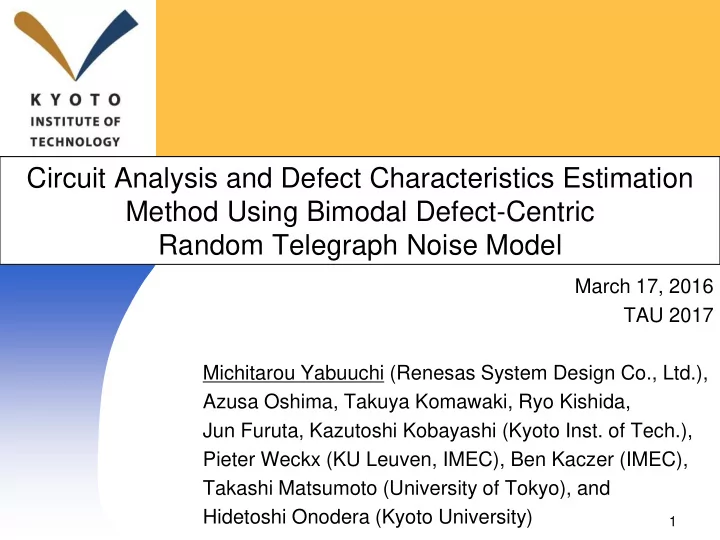

Circuit Analysis and Defect Characteristics Estimation Method Using Bimodal Defect-Centric Random Telegraph Noise Model March 17, 2016 TAU 2017 Michitarou Yabuuchi (Renesas System Design Co., Ltd.), Azusa Oshima, Takuya Komawaki, Ryo Kishida, Jun Furuta, Kazutoshi Kobayashi (Kyoto Inst. of Tech.), Pieter Weckx (KU Leuven, IMEC), Ben Kaczer (IMEC), Takashi Matsumoto (University of Tokyo), and Hidetoshi Onodera (Kyoto University) 1
Kyoto Inst. of Tech. Summary What is proposed? Defect parameter extraction method and RTN (random telegraph noise) prediction method 𝜏 𝜏 @40 nm SiON Τ Τ ∆𝐺 𝐺 ∆𝐺 𝐺 max max Measurement result of RTN Prediction by frequency fluctuation proposed method distribution by RTN 2
Kyoto Inst. of Tech. Contents Introduction Measurement of RTN Parameter extraction method Result Conclusion 3
Kyoto Inst. of Tech. Variation on scaled process -65 nm process voltage temperature process voltage RTN 40 nm- temperature More significant scaling in “small area” RTN affects the yields – CMOS image sensor – Flash, SRAM 4
Kyoto Inst. of Tech. RTN: Random Telegraph Noise Capture Emit th | |∆𝑊 t # of defect Gate area 𝑀𝑋 + + + + + + ∆𝑊 th /defect + Carier + Si 5
Kyoto Inst. of Tech. Threshold voltage shift Δ𝑊 th by RTN Defect-centric distribution 𝜈 ∆𝑊 th = 𝑂 × 𝜃 Avg. 2𝑂𝜃 2 ∝ Τ Std. dev. 𝜏 Δ𝑊 th = 1 𝑀𝑋 1 # of Defect 𝑂 ∝ 𝑀𝑋 Δ𝑊 th /defect 𝜃 ∝ 𝑀𝑋 Poisson dist. Exponential dist. 6
Kyoto Inst. of Tech. RTN in high-k process ~ 65nm 40nm 28nm Unimodal model Bimodal model Each oxide layer has its parameters High-k layer (HK) : 𝑶 𝐈𝐋 , 𝜽 𝐈𝐋 Interface layer (IL) : 𝑶 𝐉𝐌 , 𝜽 𝐉𝐌 7
Kyoto Inst. of Tech. Comparison : Unimodal vs Bimodal Unimodal model Bimodal model ( N , 𝜽 ) ( N HK , 𝜽 HK , N IL , 𝜽 IL ) CCDF × N CCDF × N ΔVth [ mV] ΔVth [ mV] SiO 2 or SiON HKMG thin HK/IL 8
Kyoto Inst. of Tech. Circuit-level RTN prediction 𝑶 𝐈𝐋 , 𝜽 𝐈𝐋 , 𝑶 𝐉𝐌 , 𝜽 𝐉𝐌 ? Calculation by bimodal model of Defect-centric distribution Defect Threshold parameter voltage shift Netlist RTN Circuit w/ ∆𝑊 prediction th Monte-Carlo circuit simulation 9
Kyoto Inst. of Tech. Purpose of this study Parameter extraction method for RTN characteristics of bimodal model of Defect-centric distribution RO measurement data Proposed 𝑶 𝐈𝐋 , 𝜽 𝐈𝐋 , 𝑶 𝐉𝐌 , 𝜽 𝐉𝐌 ! method Confirm w/ Defect Threshold parameter voltage shift measured data Netlist RTN Circuit w/ ∆𝑊 prediction th 10
Kyoto Inst. of Tech. Measurement circuit 40 nm HK/Poly-Si Process TEG x840 7-stage ring oscillator (RO) Count # of oscillation by using on-chip counter 11
Kyoto Inst. of Tech. Measurement method Conditions 9,024 times/RO 𝑊 dd = 0.65 V Δ𝑢 = 2.2 ms 𝑢 total = 20 s Fmin Δ𝐺 = 𝐺 max − 𝐺 min Calculate for each RO 𝐺 𝐺 max max 12
Kyoto Inst. of Tech. Result of frequency fluctuation distribution by RTN Follow bimodal defect-centric distribution Standard normal quantile 840 ROs 8.61% Τ ∆𝐺 𝐺 max 13
Kyoto Inst. of Tech. How to extract parameters Optimize defect vector Prior to the loop Sensitivity Analysis 𝑶 𝐈𝐋𝟒 , 𝜽 𝐈𝐋𝟒 , 𝑶 𝐉𝐌𝟒 , 𝜽 𝐉𝐌𝟒 𝑶 𝐈𝐋𝟑 , 𝜽 𝐈𝐋𝟑 , 𝑶 𝐉𝐌𝟑 , 𝜽 𝐉𝐌𝟑 𝑶 𝐈𝐋𝟐 , 𝜽 𝐈𝐋𝟐 , 𝑶 𝐉𝐌𝟐 , 𝜽 𝐉𝐌𝟐 𝑶 𝐈𝐋𝟏 , 𝜽 𝐈𝐋𝟏 , 𝑶 𝐉𝐌𝟏 , 𝜽 𝐉𝐌𝟏 KS test (calculate object function) 𝜏 𝜏 Measured data Prediction Τ ∆𝐺 𝐺 Τ ∆𝐺 𝐺 max max 14
Kyoto Inst. of Tech. Obtain threshold voltage shift Calculate Δ𝑊 th w/ defect characteristics – By using defect-centric distribution 𝑶 𝐈𝐋,𝒋 , 𝜽 𝐈𝐋,𝒋 , 𝑶 𝐉𝐌,𝒋 , 𝜽 𝐉𝐌,𝒋 Δ𝑊 Δ𝑊 Δ𝑊 thp1 thp2 thp7 ・ ・ ・ Δ𝑊 Δ𝑊 Δ𝑊 thn1 thn2 thn7 14 Tr. X 840 RO 15
Kyoto Inst. of Tech. Convert Δ𝑊 th to frequency shift (1) Prior to the loop Τ Analyze sensitivity Δ𝑊 ∆𝐺 𝐺 th to max of MOSFET – Simulation condition : same as measurement – Shift Δ𝑊 th of single NMOS and PMOS 𝑙 p 𝑙 n max PMOS ∆𝐺 𝐺 Τ NMOS Δ𝑊 th [V] 16
Kyoto Inst. of Tech. Convert Δ𝑊 th to frequency shift (2) Τ ∆𝐺 𝐺 max with sensitivities 𝑙 n , 𝑙 p Calculate INV RO Τ Τ ∆𝐺 𝐺 max = ∆𝐺 INV,𝑗 𝐺 Τ ∆𝐺 INV,𝑗 𝐺 max max = X840 RO Δ𝑊 thp,𝑗 × 𝑙 p Τ ∆𝐺 𝐺 = prediction of max + distribution Δ𝑊 thn,𝑗 × 𝑙 n 17
Kyoto Inst. of Tech. Calculation of object function Kolmogorov-Smirnov test for null hypothesis “populations of two samples are the same.” Sample #1:measured data Sample #2:prediction 𝜏 𝜏 Τ Τ ∆𝐺 𝐺 ∆𝐺 𝐺 max max Object function 𝑞 becomes larger when difference b/w two CDF plots becomes smaller. 18
Kyoto Inst. of Tech. Manipulation of defect vector Downhill simplex method Solution for optimization problem – Maximize object function 𝑞 𝒒 𝒋 𝑶 𝐈𝐋𝟒 , 𝜽 𝐈𝐋𝟒 , 𝑶 𝐉𝐌𝟒 , 𝜽 𝐉𝐌𝟒 𝑶 𝐈𝐋𝟑 , 𝜽 𝐈𝐋𝟑 , 𝑶 𝐉𝐌𝟑 , 𝜽 𝐉𝐌𝟑 𝒒 𝟑 𝑶 𝐈𝐋𝟐 , 𝜽 𝐈𝐋𝟐 , 𝑶 𝐉𝐌𝟐 , 𝜽 𝐉𝐌𝟐 𝒒 𝟐 𝑶 𝐈𝐋𝟏 , 𝜽 𝐈𝐋𝟏 , 𝑶 𝐉𝐌𝟏 , 𝜽 𝐉𝐌𝟏 𝒒 𝟏 Convergence condition 𝑞 𝑗 > 0.99 or 𝑗 MAX = 500 19
Kyoto Inst. of Tech. Prediction vs measurement data Standard Normal Quantile Prediction Measured Τ ∆𝐺 𝐺 max 20
Kyoto Inst. of Tech. Conclusion RTN prediction method by using circuit simulation with bimodal defect-centric distribution Parameter extraction method for defect characteristics of bimodal model by measurement data Replicate circuit-level RTN effect by Monte- Carlo simulation 21
Recommend
More recommend